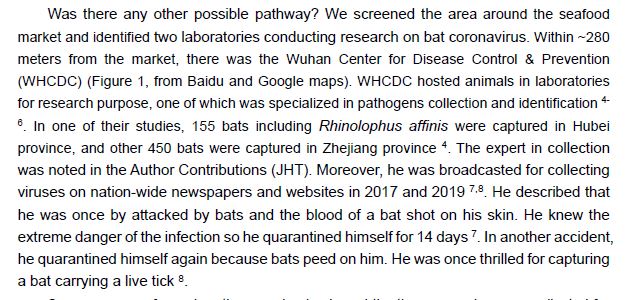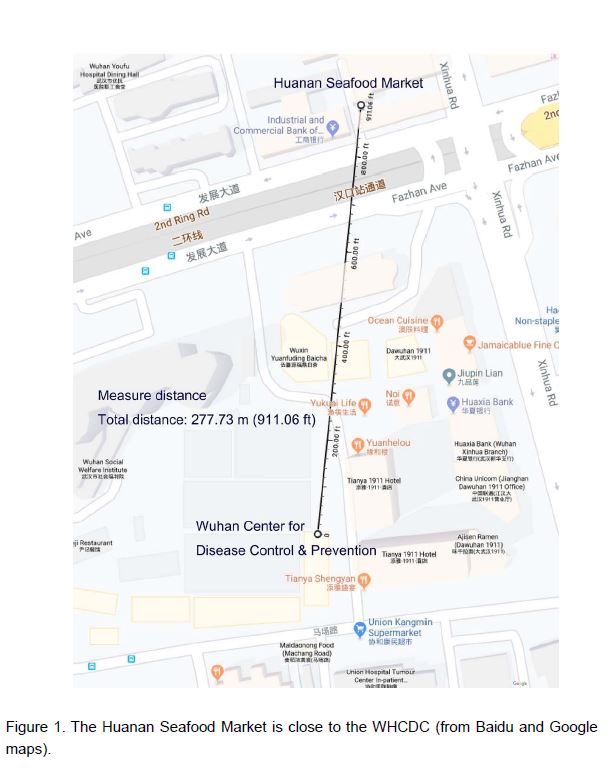Chinese researchers published a paper stating they believe that the Coronavirus originated at one of the two virus research institutes in Wuhan, China.
Reports that coronavirus had been traced to bats, most likely the kind that could be found in wet markets like the one in Wuhan, is becoming less believable. A new report from Botao Xiao and Lei Xiao of the South China University of Technology suggests that the pathogen is more the result of a leak from a lab.
Note: The REAL conspiracy theory is that bats – developed a completely new virus – left their deep caves high on a mountain – flew 900 km to a crowded and polluted city – then peed on a bunch of people – who just happened to be right next to China’s only Level 4 bioweapons lab.
The report notes that COVID-19 could be traced to the intermediate horseshoe bat — a bat that the report confirmed was not available at the Wuhan wet market and did not live locally. Native populations were no closer than 600 miles away from the first known cases, making a natural transmission from bat to human appear less likely. From the report:

The only place those particular bats existed locally was inside a research facility, which was just several hundred yards from the Wuhan wet market. The report also notes that after surgeries, some of the bio-waste ended up in some of the trash only a few meters from the wet market:

The report concluded that the coronavirus pandemic had likely been the result of a leak from the lab: “The killer coronavirus probably originated from a laboratory in Wuhan.”





Centers for Disease Control and Prevention.
Updated March 26, 2020
CDC is responding to a pandemic of respiratory disease spreading from person-to-person caused by a novel (new) coronavirus.
The disease has been named “coronavirus disease 2019” (abbreviated “COVID-19”).
COVID-19 Emergence
COVID-19 is caused by a coronavirus.
Coronaviruses are a large family of viruses that are common in people and many different species of animals, including camels, cattle, cats, and bats.
Rarely, animal coronaviruses can infect people and then spread between people such as with MERS-CoV, SARS-CoV, and now with this new virus (named SARS-CoV-2).
The SARS-CoV-2 virus is a betacoronavirus, like MERS-CoV and SARS-CoV.
All three of these viruses have their origins in bats.
The sequences from U.S. patients are similar to the one that China initially posted, suggesting a likely single, recent emergence of this virus from an animal reservoir.
Early on, many of the patients at the epicenter of the outbreak in Wuhan, Hubei Province, China had some link to a large seafood and live animal market, suggesting animal-to-person spread.
Later, a growing number of patients reportedly did not have exposure to animal markets, indicating person-to-person spread.
Person-to-person spread was subsequently reported outside Hubei and in countries outside China, including in the United States.
*****
National Institute of Health
Coronaviruses: An Overview of Their Replication and Pathogenesis
Anthony R. Fehr and Stanley Perlman
SARS-CoV, a group 2b β-coronavirus, was identified as the causative agent of the Severe Acute Respiratory Syndrome (SARS) outbreak that occurred in 2002–2003 in the Guangdong Province of China.
It is the most severe disease caused by any coronavirus.
During the 2002–2003 outbreak approximately 8098 cases occurred with 774 deaths, resulting in a mortality rate of 9%.
This rate was much higher in elderly individuals, with mortality rates approaching 50% in individuals over 60 years of age.
Furthermore, the outbreak resulted in the loss of nearly $40 billion dollars in economic activity, as the virus nearly shut down many activities in Southeast Asia and Toronto, Canada for several months.
The outbreak began in a hotel in Hong Kong and ultimately spread to more than two dozen countries.
During the epidemic, closely related viruses were isolated from several exotic animals including Himalayan palm civets and raccoon dogs.
However, it is widely accepted that SARS-CoV originated in bats as a large number of Chinese horseshoe bats contain sequences of SARS-related CoVs and contain serologic evidence for a prior infection with a related CoV.
In fact, two novel bat SARS-related CoVs were recently identified that are more similar to SARS-CoV than any other virus identified to date.
They were also found to use the same receptor as the human virus, angiotensin converting enzyme 2 (ACE2), providing further evidence that SARS-CoV originated in bats.
Although some human individuals within wet animal markets, had serologic evidence of SARS-CoV infection prior to the outbreak, these individuals had no apparent symptoms.
Thus, it is likely that a closely related virus circulated in the wet animal markets for several years before a series of factors facilitated its spread into the larger population.